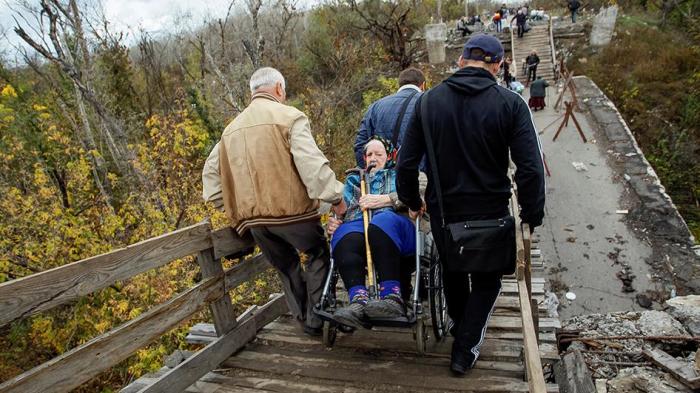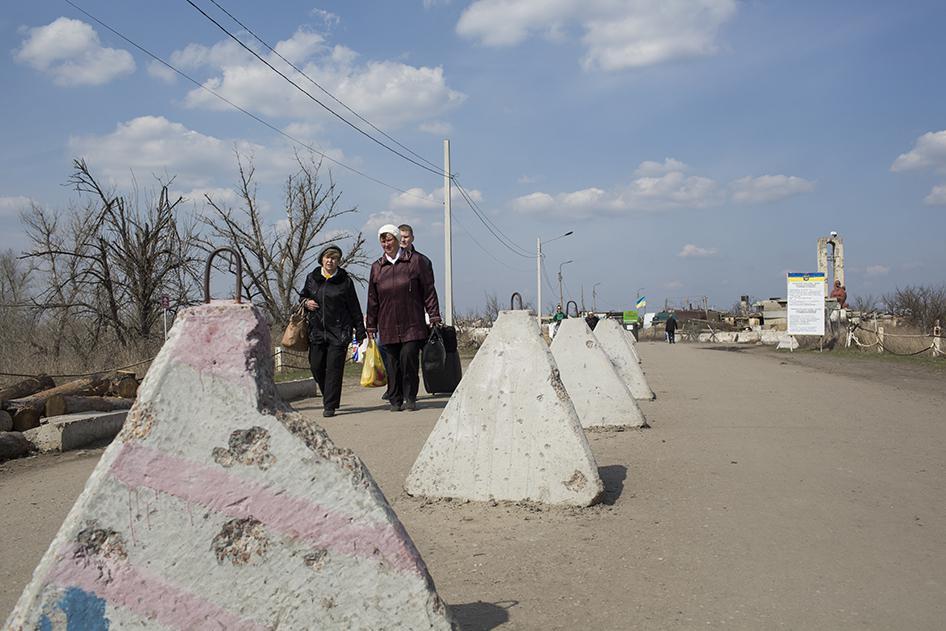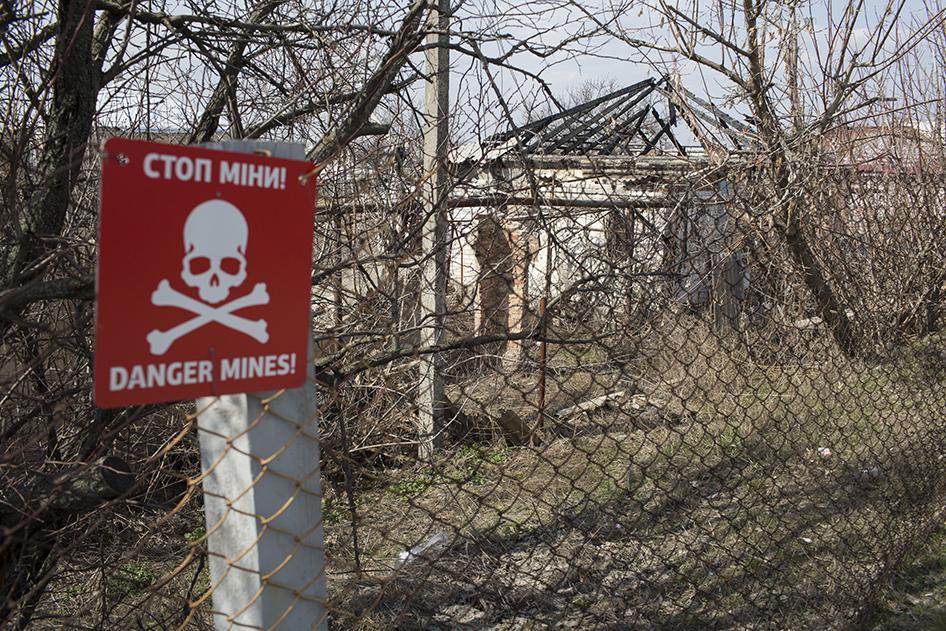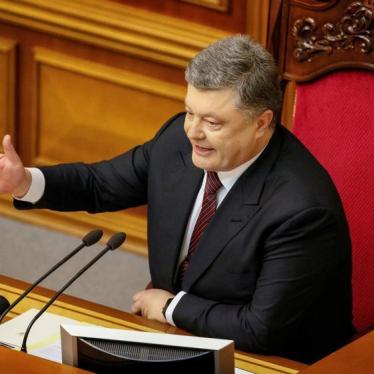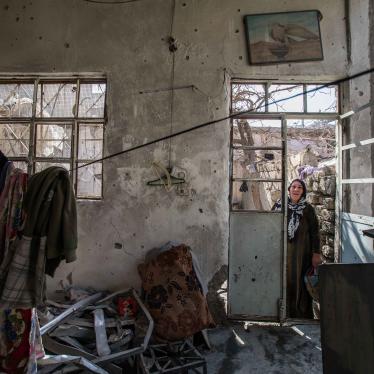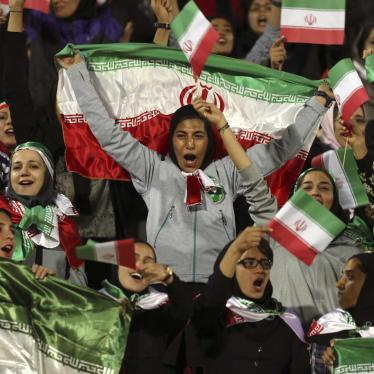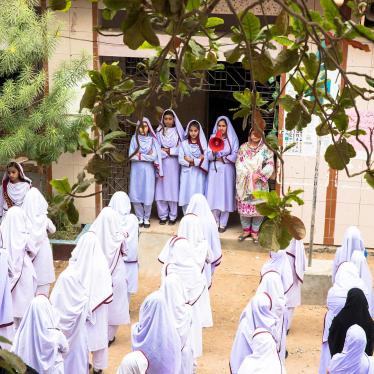(Kyiv) – Older people who need to travel between the Luhansk region of eastern Ukraine and government-controlled areas face arbitrary obstacles, including risks to their health and safety, Human Rights Watch said today.
A central problem is that those in control of the area have not made the bridge at Stanitsa Luhanska, the sole crossing point in the region, safe for civilians. The government requires people who live in the armed group areas of Donetsk and Luhansk to register as displaced persons and maintain a residence in government-controlled areas to get their pensions. Older people may also have family on both sides or may need to cross to get services such as health care.
“Having to cross the conflict line is a reality thousands of older Ukrainians face routinely, and Stanitsa Luhanska is a treacherous crossing with very little assistance,” said Tanya Cooper, Ukraine researcher at Human Rights Watch. “Both parties to the conflict should, as a priority, facilitate freedom of movement by repairing the bridge and making the crossing safe and accessible for everyone.”
The Ukrainian government and Russia-backed armed groups should ensure that the crossing point is safe for civilian use, with adequate services at the checkpoints.
Every month, more than a million people, about half of them older people, cross the line of conflict separating government-controlled areas of the Donetsk and Luhansk regions in eastern Ukraine from areas controlled by armed groups. All four crossings in the Donetsk region are accessible by motor vehicle. In Luhansk region, however, the only crossing is open, where the Stanitsa Luhanska bridge used to stand. The bridge was so badly damaged during the armed conflict that cars can no longer travel on it. To cross on foot, people must make their way down a steep ramp, cross a portion of a collapsed bridge, and climb another steep ramp on the opposite side.
This crossing is served by an unpaved, gravel road on the non-government-controlled side and in the so-called “grey zone” territory, which neither side controls.
The crossing is dangerous for everyone but can be particularly difficult for people with disabilities and older people. When Human Rights Watch visited in March, April, and October 2018, staff of humanitarian organizations repeatedly said that they had seen people fall on the ramps, including older people. The wooden ramps, in addition to being perilously steep, are unstable and can become slippery with rain or snow.
The Ukrainian authorities have two wheelchairs available at the crossing, but as of October, only one was usable. Only one Emergencies Ministry staff person, tasked with looking after infrastructure at the crossing point, was available to help people cross. Wheelchairs cannot be used on the ramps. Older people frequently have no choice but to pay an untrained “mover” to push them in carts or sleds or physically carry them across the makeshift bridge.
The long lines on both sides are also difficult for older people. Ukrainian authorities told Human Rights Watch that older people and people with disabilities are allowed priority crossing, which means they are allowed to skip the general waiting line and cross. But that is rarely enforced, and getting permission is burdensome.
Since 2016, the overall number of crossings over the separation line has steadily increased. Many aid workers said they believe this is due to the discriminatory pension rules. They saw a sharp increase at the Stanitsa Luhanska checkpoint, where thousands cross every month.
According to the UN Office for the Coordination of Humanitarian Affairs (OCHA), while reconstruction work was carried out in early September at the crossing point, the “lack of adequate facilities and access to emergency care remained a concern.” The OCHA reported that an older woman was injured at the crossing point in September, when a large crowd rushed to cross the bridge.
Both parties to the armed conflict should take steps to allow for the reconstruction of the broken bridge to allow cars and public transportation to cross; ensure that the crossings are safe, posted with information about priority status; and ensure accessibility and needed assistance for people who need help crossing.
The de facto authorities of the Luhansk and Donetsk regions should ensure that there is adequate, and adequately-maintained, basic sanitary and protective infrastructure for people waiting to cross, and wheelchairs and staff for people who ask for help.
The Ukrainian government should ensure delivery of impartial humanitarian aid to the most vulnerable populations; allocate sufficient funds to provide facilities for safe, accessible, and dignified conditions, including adequate maintenance; and provide sufficient staff and punctual public transportation at the checkpoints. It should ensure that family members and other people can help people with priority status to cross and enforce the requirement not to require permit renewals.
The United Nations High Commissioner for Refugees (UNHCR) and the Ukrainian government should ensure that the allocated funds benefit all internally displaced people without discrimination. The European Union, United States, and Canada should ensure that programs they fund benefit older people, people with disabilities, and other at-risk groups on an equal basis with others. The UNHCR and the Ukrainian government should also issue clear guidance to field staff to identify and register older people and people with disabilities, including disabilities that are not visible, such as dementia.
“Older people shouldn’t have to risk their health and safety to get their pensions or medical treatment or to visit their relatives on the other side of the conflict line,” Cooper said. “Both parties to the conflict need to facilitate crossing, with repairing the bridge as a first step.”
For detailed findings, please see below.
Human Rights Watch conducted research along the line of contact in March, April, and October 2018, and followed up by email and phone with organizations that provide humanitarian and legal support in the crossing areas.
A Human Rights Watch researcher who is a native Russian speaker interviewed more than several dozen people, ages 55 to 84, at three crossing points open to vehicles in the Donetsk region – Mayorsk, Mariinka, and Novotroitske – and at the sole crossing point in Luhansk region, at Stanitsa Luhanska. Human Rights Watch also spoke with staff members of seven Ukrainian nongovernmental groups and international organizations that provide assistance to internally displaced people and civilians living next to the line of contact.
In March and April, the researcher visited the crossing point at Stanitsa Luhanska on the government side and was able to access only the part of the crossing point up to the bridge. Human Rights Watch has not had access to the armed group territories in two years. Human Rights Watch talked to numerous local and international organizations, located on the government-held side, that have access to the area controlled by the armed groups of the so-called Luhansk People’s Republic. A Human Rights Watch researcher visited the Stanitsa Luhanska crossing point again in October 2018, after Ukrainian authorities made several improvements to the infrastructure.
A Burden for Older People
According to the United Nations, older people “constitute a significant proportion of the conflict-affected population in Ukraine, making up almost 30 percent of the 3.4 million people in need of humanitarian assistance and protection, and half of registered displaced people.” Ukraine also has the largest percentage of older persons affected by armed conflict in a single country, according to the UN.
Every day, thousands of people cross the line of contact in Donetsk and Luhansk regions. The trip is dangerous and physically demanding, and takes a particular toll on older people. According to a recent survey data by Right to Protection, a charity foundation that conducts monitoring and provides legal assistance for displaced people in eastern Ukraine, more than half of the people who crossed throughout 2018 were older people, “which is related to the administrative burdens people from [non-government-controlled areas] must undergo to receive their pensions.”
According to the UN in Ukraine, older people and people with disabilities are among the most vulnerable in the conflict-affected area of eastern Ukraine, due to limited mobility and lack of primary healthcare and rehabilitation services. The UN estimates that 1.6 million people living in close proximity to the line of conflict on both sides are over age 60 and have at least one chronic illness.
Sanitary conditions at the checkpoints Human Rights Watch visited on the Ukrainian government side in Donetsk region have improved since visits there in November 2016 and July 2017. Nevertheless, there are long lines, insufficient assistive devices and services for people with limited mobility and other disabilities; priority crossing for vulnerable people was still not routinely provided. The problems were most egregious at Stanitsa Luhanska. No basic sanitary facilities, drinking water, and medical aid are available in the grey zone, the area between checkpoints controlled by Ukraine and Russia-backed armed groups.
Stanitsa Luhanska
To cross from Ukrainian government-controlled territory to Luhansk, at Stanitsa Luhanska, people must walk 1.5 kilometers to the collapsed bridge, which is sunken to near ground level, and climb up and down unstable and dangerous, sloping wooden ramps at both ends. Then they must walk another 1,200 meters on the armed group-controlled side before they can get motor transport. Staff of international aid organizations working at the crossing point repeatedly told Human Rights Watch that they had seen people fall on the makeshift bridge due to its slippery, unstable surface.
According to Ukraine’s State Border Guard Service, from January through October, there were 2.67 million crossings there in both directions.
Long Lines
There are long lines at Stanitsa Luhanska, particularly on the government-controlled side. In March and April, several staff of local and international organizations working there said they often see people, including older people, running to get a place in line, with some falling and hurting themselves. They also said that people often have to wait for several hours in extreme temperatures, which can be particularly taxing on older people.
In September, the Ukrainian authorities increased the number of passport control booths and staff. There are now 20 booths at both entry and exit points. However, when a Human Rights Watch researcher visited in October, only a few booths were open, with 400 to 450 people waiting to cross into the non-government-controlled territory. The line did not diminish for at least three hours. The overwhelming majority of those waiting were older people.
A dozen older people told Human Rights Watch that Ukrainian border guards “open all the booths when the monitors from the Organization for Security and Co-operation in Europe (OSCE) arrive.”
While Ukrainian authorities said they allowed priority crossing for older people and people with disabilities, among others, in practice the priority crossing is not always enforced and there is no information about priority crossing with clear eligibility rules at the crossing.
Older people with disabilities said that Ukrainian border guards often did not allow them to use the priority line without a hard copy of a certificate confirming their disability. Many older people in eastern Ukraine do not register their disability status as disability benefits are small and the procedure to obtain disability status is time-consuming and bureaucratic.
A 75-year-old woman, Valentina (not her real name), interviewed at Stanitsa Luhanska, said that she crosses regularly to visit a local cemetery where her husband and her parents are buried. She uses a cane. When Human Rights Watch spoke with her in early April, she had left her home in the area of Luhansk region not controlled by the government early in the morning because the side of the crossing point controlled by armed groups was “bad and one can slip,” so she had to walk very slowly to avoid falling:
When you walk [on the ramps], the railings shake. I nearly fell there.
They [the wooden ramps replacing the bridge at Stanitsa Luhanska] are so high up. It’s bad. I was scared that my shoes would slip on it. I will get my pension money here and go back. Once I did not cross in time and it was late, dark. I couldn’t get a room anywhere, nothing. […] I’d never think that this kind of thing could happen in my old age.
Valentina said it took her an hour to walk two kilometers between the two sides. She said that because she lacks official documentation of her health conditions and limited mobility, officials on the government-controlled side do not allow her to use priority crossing. However, she said she sometimes can skip the regular line on the side controlled by the armed groups in Luhansk:
On the Ukrainian side, they don’t let you skip. But on that side, sometimes, if someone is nice, they let you go without waiting in the line. I was standing in line, the sun was scorching, and I began feeling sick. I went into the shade. And a border guard says: ‘Grandma, go through.’
If only they would do something with this bridge, so it’d be possible to drive up there with something. It would be good to not have to go down but just walk on a flat surface and be on my way.
An older couple, ages 80 and 84 and both in wheelchairs, said that officials allowed them to skip the general line due to their health, and the crossing was hard. Their family members accompanied them to push the wheelchairs up to the crossing. The couple’s daughter said that she regularly paid so-called “movers” to help her to carry her parents and their wheelchairs down and up the steep ramps. Each mover charged 50 to 100 Ukrainian hryvnas (approximately US$2 to $4), expensive relative to Ukraine’s minimum monthly pension of 1,435 hryvnas (US$51).
The couple said that they would not have travelled across the line of conflict in their condition so often if they were not required to confirm their pension status and collect their pension each month. The woman said:
We worked…so just to leave everything here – it does not feel right. It’s hard for me. I can barely move. […] First, the movers have to take me down and up the broken bridge, then they have to do the same with my wheelchair. You see, at my age… I barely move, I can slip even when it’s a flat surface.
Her husband said:
In October, older people and officials with Ukraine’s Emergencies Ministry told Human Rights Watch that border guards allowed priority crossing only to people who have a certificate to confirm their “category 1 disability status,” issued for people dependent on others for support due to a documented health condition, or who are age 90 or older. People interviewed said that medical staff at the crossing point could recommend people for priority crossing due to their health condition.In the winter the weather is terrible, and it’s pure ice here. It’s unbearable. It’s not just difficult, it’s extremely difficult. I just feel so bad for my [daughters]. There’s nowhere to turn, they just carry us on themselves. […] They should force our authorities to cross this bridge during bad weather – then they would fix it.
However, even if a person’s health condition qualifies them for priority crossing, their family members or other people accompanying and supporting them are not entitled to cross with them. This means that most wait for hours in line rather than be left without support.
In October, a 70-year old man said that he had broken his leg and had to use crutches and a wheelchair. Ukrainian border guards told him he could cross without waiting in line, but his wife could not. He said that he did not want to be separated from his wife and chose to stand in the 400-person line instead.
Insufficient Assistance for People with Limited Mobility
At the time of the visits to Stanitsa Luhanska in March and April, only one of the crossing’s two wheelchairs was available, which was inadequate for a pedestrian-only crossing.
One Emergencies Ministry official at the crossing point is tasked with helping people with disabilities cross. The lack of additional personnel increases waiting times, since several people often need help at the same time.
All those interviewed said that they did not see any wheelchairs on the side controlled by armed groups. At most crossing points, including Stanitsa Luhansk, there is no information about what services are available for older people and people with disabilities on either side, so people who need help may not be aware that a wheelchair and an Emergencies Ministry official are available.
In March, Human Rights Watch saw an older man with one leg arriving at the Ukrainian side of the Stanitsa Luhanska crossing point. He waited in the Emergencies Ministry tent for whom to ask for help. When the ministry official finished helping someone else cross the crossing point and came into the tent, he said: “Old man, it’s just me here. If you’re not heavy, I’ll help you, if you are, then I can’t.”
That official told Human Rights Watch that to be able to use a wheelchair and receive assistance, people need to put their names on a list and wait their turn. People waiting in the tent told Human Rights Watch that they had been waiting for “a long time.”
Facing this lack of staff and resources, people have no choice to but hire the “movers.” The authorities on both sides informally allow the “movers” to operate.
In March, after a heavy snowfall, Human Rights Watch saw several men who had affixed an old seat from a car to the top of a sled and were offering to transport people between the two checkpoints at Stanitsa Luhanska for pay.
Although UNHCR had given several wheelchairs to the Ukrainian authorities at the Stanitsa Luhanska crossing, only one seemed to be available. An aid worker there said that wheelchairs often break down because of poor road conditions and the heavy demand for use. Human Rights Watch saw people struggling to move wheelchairs in melting snow. A few weeks later, after the snow had melted, people struggled to move wheelchairs on the unpaved one-kilometer rutted, muddy road leading to the bridge.
Since then, the Ukrainian side of the Stanitsa Luhanska crossing point has been paved with asphalt, a significant improvement. However, the paving stops at the “gray zone,” about 500 meters before the bridge, after which people in wheelchairs need “movers” to carry them and their belongings.
In October, an official with the Emergencies Ministry said that although they had two wheelchairs at the crossing point, “in reality we only have a half of a wheelchair, because they got quickly worn out on the rugged road inside the crossing point. We try to fix them with wires and whatever we can, but it does not help much.”
Sanitary and Other Facilities
In October 2017, Ukraine’s prime minister ordered the civil-military administrations in Luhansk and Donetsk regions to identify municipal public services to maintain sanitary and other facilities at checkpoints in their regions. However, the facilities provided by international donors at the Stanitsa Luhanska and other crossing points often lack sufficient maintenance, and at others are completely neglected.
In September, Ukrainian authorities replaced many latrines at the Stanitsa Luhanska crossing point, but they still do not have adequate maintenance. There are only four latrines on the Ukrainian side, with constant lines. None are accessible for people with disabilities because they have steps at the entrance and lack assistive devices, such as grab bars, inside.
In October, a Human Rights Watch researcher used one of the latrines. It lacked proper sanitary maintenance and a lock. The remaining three were in the same condition. A few latrines are available in the grey zone. Staff of aid groups and people Human Rights Watch interviewed said that the number of latrines is also insufficient on the other side.
Activists who monitor the humanitarian situation and people who regularly cross said there are some sanitary facilities and shelter from extreme weather on the side controlled by armed groups in Luhansk region. They also said that a medical unit, provided and staffed by the International Committee for the Red Cross (ICRC), operates on that side. In addition to emergency medical care, people can get water and hot tea at the ICRC unit.
Permit System
In January 2015, the Ukrainian government began enforcing travel regulations that require civilians to obtain a special electronic pass to move between armed group-controlled and government-controlled territories. Civilians can apply online or in person, and the e-permit is valid for one year.
Ukrainian border guards do not allow people to pass in either direction if there is even a minor discrepancy between information on one’s e-permit and one’s passport, such as one letter in the person’s name, one digit in the person’s passport number, or if the pass has expired.
Those who are stopped have to make corrections either online or in person and can cross only when a corrected e-pass is issued.
In 2016, the UN said the permit system creates “an unnecessary barrier, especially for older people without access to internet or computers.” In April 2017, authorities amended regulations to allow crossing permits to be valid indefinitely. However, the amendment has not been carried out. Older people interviewed in March and April said they still struggle with the permit application process.
Applicable Legal Standards
Ukraine is a party to several international human rights treaties, including the European Convention on Human Rights (ECHR), the International Covenant on Civil and Political Rights (ICCPR), the International Covenant on Economic, Social and Cultural Rights (ICESCR), and the Convention on the Rights of Persons with Disabilities (CPRD). Both parties to the conflict must also respect international humanitarian law applicable to non-international armed conflict.
The ECHR and the ICCPR both protect the right to freedom of movement within a territory and rights to home and family. In each case, the conflict line can interfere with certain aspects of those rights. While none of those rights are absolute and the existence of the conflict line is not in and of itself a violation of those rights, authorities should ensure that people can cross the line as expeditiously and safely as practical and that there are not undue barriers caused, for example, by procedural, bureaucratic delays or avoidable logistical issues. The same applies when crossing the line is necessary for rights the ICESCR protects, such as the right to health.
International humanitarian law provides that older people and people with disabilities are entitled to respect and protection. The CRPD also requires countries to take measures “in accordance with their obligations under international law, including international humanitarian law and international human rights law […] to ensure the protection and safety of persons with disabilities in situations of risk, including situations of armed conflict, humanitarian emergencies and the occurrence of natural disasters.”

